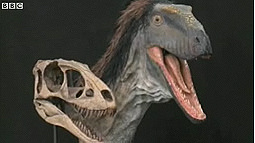T. Rex in Miniature
The going theory about the Tyrannosaurus rex, in case you didn't know, had been until very recently that this famous mega-dinosaur sported stumpy little arms as an evolutionary adaptation related to its jumbo body size. Then a fossil of Raptorex kriegsteini -- perhaps 1/100th the size of T. rex, its descendant -- came along and upended that notion with its own disproportionately puny forelimbs.
The going theory about the Tyrannosaurus rex, in case you didn’t know, had been until very recently that this famous mega-dinosaur sported stumpy little arms as an evolutionary adaptation related to its jumbo body size. Then a fossil of Raptorex kriegsteini — perhaps 1/100th the size of T. rex, its descendant — came along and upended that notion with its own disproportionately puny forelimbs. –KA
Your support matters…BBC:
A 3m-long dinosaur fossil from China which predates T. Rex by 60 million years is a blueprint for the mighty carnivore, say researchers.
They tell Science magazine that the fossil displays the same features as T. rex but in miniature.
The new species, Raptorex kriegsteini, would have weighed around 65kg; its descendants were 90 times as massive.
Scientists believe it could be the “missing link” between earlier species of dinosaur and T. rex.
The 125-million-year-old specimen suggests that T. rex’s characteristic big head with enhanced jaw, relatively small forearms and huge back legs were inherited from this much smaller dinosaur, and that the body type changed little over millions of years except in size.
Independent journalism is under threat and overshadowed by heavily funded mainstream media.
You can help level the playing field. Become a member.
Your tax-deductible contribution keeps us digging beneath the headlines to give you thought-provoking, investigative reporting and analysis that unearths what's really happening- without compromise.
Give today to support our courageous, independent journalists.






You need to be a supporter to comment.
There are currently no responses to this article.
Be the first to respond.